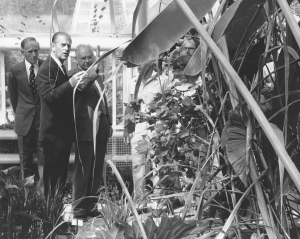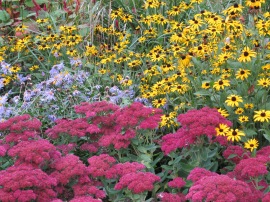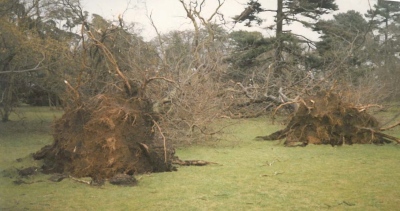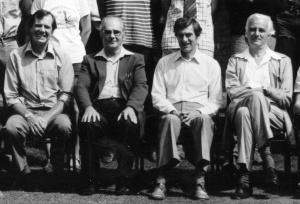● 150th Anniversary of New Botanic Garden ● Key Events ● National Plant Collections ● Biodiversity ● Royal Tropical Glasshouse Opening ● Gilmour Education Building ● The Great Storm ● Nature Conservancy Council ● International Environmental Concerns ● Key People ●
 The old teak Tropical Palm House was replaced by a new Tropical Glasshouse – in an innovative design of marine-quality paint of white steel – in 1989. The new building was officially opened by HRH The Duke of Edinburgh on 16th June 1989
The old teak Tropical Palm House was replaced by a new Tropical Glasshouse – in an innovative design of marine-quality paint of white steel – in 1989. The new building was officially opened by HRH The Duke of Edinburgh on 16th June 1989
 150th Anniversary of New Garden
150th Anniversary of New Garden
In 1981, the Cambridge University Botanic Garden celebrated the 150th Anniversary of the ‘New’ Botanic Garden. By the early nineteenth-century, the original Botanic Garden, established in 1762, had become too small. In 1831, John Stevens Henslow, then Professor of Botany, persuaded Cambridge University to purchase a 16-hectare site from Trinity Hall on which to create his new Garden; planting finally began in 1846.
To mark the 150 years, Dr Max Walters (Director 1973 – 1983) published a history of the Garden entitled: The Shaping of Cambridge Botany: A Short History of Whole-Plant Botany in Cambridge from the time of Ray to the Present Century.
Max Walters’ book tells the story of the development of the science of botany from the mid-seventeenth century, beginning with scientific pioneer, John Ray. As the sub-title suggests, Max Walters focuses his study on whole-plant botany as opposed to the developing areas of 20th-century plant science – genetics, plant physiology and ecology. Max Walters retired as Director of the Botanic Garden after ten years, in 1983.
Rationalisation Despite the 150-year celebrations and continuing high national and international profile of the Botanic Garden, finances were cause for concern in the mid-1980s. New Director, Dr Donald Pigott (1984 – 1995) took difficult decisions to raise the capital fund, Cory Lodge, was converted into Garden offices, 1 Brookside was leased, and 47 Bateman Street and land next to Brooklands Avenue was sold. In 1989, a trial £1.00 admission charge to enter the Garden on Sundays was introduced to contribute towards ‘the cost of educational facilities for the public’.
Royal Tropical Glasshouses Opening His Royal Highness, The Duke of Edinburgh, Chancellor of the University, officially opened the new Tropical Glasshouse on 16th June 1989. (Above left) The Duke installs the plaque at the rear of the new Tropical Palm House. He also planted a Quercus castaneifolia tree in the Garden.
 Funding for the new Palm Glasshouses came from various sources – the Cambridge University, private donations, The Cory Fund, Friends of the Botanic Garden and an anonymous benefactor.
Funding for the new Palm Glasshouses came from various sources – the Cambridge University, private donations, The Cory Fund, Friends of the Botanic Garden and an anonymous benefactor.
(Right) HRH The Duke of Edinburgh, Chancellor of University of Cambridge at the official opening in 1989.
Key Events in the 1980s
1981 150th Anniversary of the New Botanic Garden
1981 The Shaping of Cambridge Botany by Dr Max Walters published
1981 National Collection of Plants
1982 The Falklands War
1983 Peter Orriss and Roy Lancaster in BBC Gardeners’ World programme
1983 Dr Max Walters (1973 – 1983) retires as Director after ten years
1983 Professor Richard West caretakes Garden between Oct 1983 – Sept 1984
1984 Professor Donald Pigott takes up Directorship in Sept
1984 Cory Lodge converted to offices. Cory Lodge Garden opened in 1987
1985 Colour Supplement features Winter Garden on 10th February 1985
1986 Temperate House opened by Michael Bevan, Lord Lieutenant of Cambridgeshire
1986 The Winter Garden Features on Anglia TV’s Gardens for All
1987 The Great Storm of 1987
1987 Nature Conservancy Council three-year contract for British Native Plants survey
1987 Cory Laboratory conversion into modern lab facilities supported by Cory Fund
1987 The Botanic Gardens Conservation Secretariat established
1987 47 Bateman Street sold to St Mary’s School, 1 Brookside leased to St Catherine’s
1988 Plot of land by Brooklands Avenue sold to boost the Garden’s funds
1988 Botanic Garden and Cambridge City Council win Silver-Gilt medal at Chelsea
1988 Prime Minister, Mrs Thatcher ‘goes green’ in a speech to the Royal Society
1989 The Gilmour Building opens
1989 The Tropical Greenhouse officially opened by HRH The Duke of Edinburgh
 Biodiversity
Biodiversity
Biodiversity has become a conservation issue as natural habitats have been damaged or lost. ‘Biological diversity‘ or ‘biodiversity’ are terms developed in 1985 to refer to the diversity or variety of living plants, animals and micro-organisms. This includes all living and natural systems. It is these systems that humans depend on for their everyday life and survival – medicines, foods, energy.
 National Plant Collections®
National Plant Collections®
The idea of National Plant Collections® was to be ‘as complete a representation of a genus or section of a genus as possible’. The National Council for the Conservation of Plants and Gardens (NCCPG), now Plant Heritage, was founded by a group of botanists, horticulturalist, conservationists and gardeners in 1978. It aims are to: encourage the propagation and conservation of cultivated plants in the British Isles; encourage and conduct research into cultivated plants, their origins, their historical and cultural importance and their environments; and encourage the education of the public in cultivated plant conservation.

Today, the Cambridge University Botanic Garden holds nine National Plant Collections®. The earliest was designated in 1981. The collections are associated with various botanists and taxonomists that worked or researched in the Garden across the decades. For example, Dr Max Walters was an acknowledged specialist in the genus Alchemilla and wrote many scientific papers on it. One of the most common varieties is Lady’s Mantle Alchemilla mollis. Alchemilla are unusual in that they able to produce seed without fertilization of the flowers, this is known as apomixis. Together with Dr David Webb of Trinity College, Dublin, Max Walters also built up a national collection of Saxifraga.
 Thanks to the work of Taxonomist Dr Peter Yeo, the Garden developed collections of the Geranium, Ruscus, Bergenia or ‘elephant ears’. The Fritillaria (European species) Collection was the work of Dr Martyn Rix, editor of Curtis’s Botanical Magazine, who carried out PhD research on the genus in the 1970s. Dr Li Zhu, Garden Taxonomist after Dr Yeo, cultivated the Lonicera, or honeysuckle collection.
Thanks to the work of Taxonomist Dr Peter Yeo, the Garden developed collections of the Geranium, Ruscus, Bergenia or ‘elephant ears’. The Fritillaria (European species) Collection was the work of Dr Martyn Rix, editor of Curtis’s Botanical Magazine, who carried out PhD research on the genus in the 1970s. Dr Li Zhu, Garden Taxonomist after Dr Yeo, cultivated the Lonicera, or honeysuckle collection.
The Gilmour Education Building
The Gilmour Building was opened in 1989 by Molly Gilmour. This was the first public building in the Garden designed for public talks, lectures and as a cafe space to serve food and drinks. The building was dedicated to John Gilmour (Director 1951 – 1973), who had founded the ‘new’ Eastern Garden. The cruciform building was demolished in 2005 as part of the expansion for the Sainsbury Laboratory for Plant Sciences. The new Garden Cafe in the new development has been named The Gilmour Suite, in memory of John Gilmour and his contribution to the shaping of the Botanic Garden.

The Great Storm On the evening of 15th October 1987, 122 miles an hour winds ripped through the British countryside felling trees and causing considerable structural damage to buildings. The Botanic Garden lost 50 trees – including several of its ‘foundation trees’ – in the storm. These trees had been planted in the nineteenth century at the foundation of the ‘new’ Botanic Garden.
 Having a Botanic Garden that could accommodate a research collection of trees was one reason that the 19th-century Professor of Botany, John Henslow, had wanted to create a new Botanic Garden.
Having a Botanic Garden that could accommodate a research collection of trees was one reason that the 19th-century Professor of Botany, John Henslow, had wanted to create a new Botanic Garden.
The physical storms of 1987 were a precursor of other storms that would shake the Botanic Garden during the 1990s. The Garden came under Review by the University at the time of the retirement of Professor Richard West. Read in 1990s how the Garden survived to become a stronger and more vibrant Garden for the 21st century.
Nature Conservancy Council (NCC) was a post-WWII government agency with a remit to manage nature reserves and conservation areas in the UK. The NCC had developed out of the Nature Conservancy which started after WWII to manage and advise on conservation interests. In 1987, the Nature Conservancy Council was awarded a three-year contract (1987 – 1990) to survey British Native Plants and ‘to re-establish a selection of these species at, or close to their former localities’ using ecological studies. Reintroductions included Damasonium alisma Starfruit and Leersia oryzoides Rice Grass. This survey, led by Gigi Crocker, was centered in Cambridge where the charity was given office space in the Botanic Garden. In 1991, the NCC was divided into three regional organisations – English Nature, Scottish Natural Heritage and the Countryside Council for Wales.
International Environmental Concerns There is growing concern about pollution, the environment and biodiversity in the wake of a series of high profile man-made disasters. These include the 1986 Chernobyl nuclear disaster (Russia), 1988 Piper Alpha oil disaster (North Sea) and, in 1989, the Exxon Valdez tanker accident (Alaska). As a result of these large-scale accidents, local and international plant and marine habitats were severely affected. These events, as well as concerns about global climate change and water resources would lead to the United Nations Conference on Environment and Development, the First Earth Summit, in Rio de Janerio, Brazil, in 1992.
Key People
Dr Stuart Max Walters 1973 – 1983
Max Walters retired as Director of the Botanic Garden in 1984.
Plant Taxonomist, Pioneering Conservationist, Lecturer, Co-author of Flora, Editor, Pacifist. Read more about Max Walters, his career and influence on the Garden.
New Director Donald Pigott was Professor of Botany at Lancaster University before he became Director in 1984. His connection with the Botanic Garden dates back to 1946 when he came up to Cambridge as an undergraduate to read Botany. Donald Pigott shared a live-long interest with Max Walters and, together with Franklyn Perring, they were central in mapping the flora of Britain for the Botanical Society of the British Isles.
 From left: Norman Villis, Peter Orriss, Peter Yeo and Max Walters in 1980.
From left: Norman Villis, Peter Orriss, Peter Yeo and Max Walters in 1980.
Peter Orriss (1955 – 1987) Garden Superintendent. Peter retired after working in the Garden for 51 years. Read more about Peter Orriss, his career and influence on the Garden
Norman Villis (1974 – 1997)
Garden Supervisor 1974 – 1995; Acting Garden Superintendent 1995 – 1997. Together with Garden Supervisor, Norman Villis, Peter Orriss was involved in the design and planning of many of the plantings. The most renowned is the new Winter Garden which was moved to its current location in 1978 -1979. Another important landscaping was the design and construction of the Dry Garden, a practical demonstration in creating a local suburban garden that did not require watering. Read more about Norman Villis.
Voices from the 1980s Listen to Professor Donald Pigott about his friend Max Walters. Norman Villis on the four Cambridgeshire ecological habitats.

Garden from the Air A birds-eye view of the Botanic Garden on a beautiful frosty winter’s day taken from a cherry-picker crane.
Follow the Story of the Botanic Garden as it has grown, expanded and changed since WWII: A Garden through time, 1950s Brave New Garden, 1960s Ecology by Design, 1970s Conservation, Conservation, Conservation, 1990s Sustainability for Survival, 2000s Engaging with Plant Sciences, The Future is Now.




